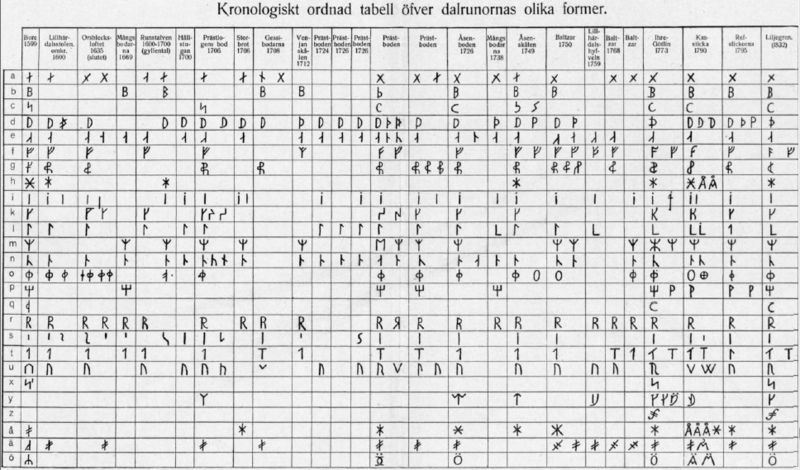- Dalecarlian runes
-
Dalecarlian runes Type alphabet Languages North Germanic languages Time period 16th to 20th centuries Parent systems Phoenician alphabet- Greek alphabet
- Old Italic alphabets
- Elder Futhark
- Younger Futhark
- Medieval runes
- Dalecarlian runes
- Medieval runes
- Younger Futhark
- Elder Futhark
- Old Italic alphabets
Note: This page may contain IPA phonetic symbols. The Dalecarlian runes, or dalrunes, was a late version of the runic script that was in use in the Swedish province of Dalarna until the 20th century.[1] The province has consequently been called the "last stronghold of the Germanic script".[1]
When Carl Linnaeus visited Älvdalen in Dalarna in 1734, he made the following note in his diary:
The peasants in the community here, apart from using rune staves, still today write their names and ownership marks with runic letters, as is seen on walls, corner stones, bowls, etc. Which one does not know to be still continued anywhere else in Sweden.[2]The Dalecarlian runes were derived from the medieval runes, but the runic letters were combined with Latin ones, and Latin letters would progressively replace the runes. At the end of the 16th century, the Dalecarlian runic inventory was almost exclusively runic, but during the following centuries more and more individual runes were replaced with Latin characters. In its last stage almost every rune had been replaced with a Latin letter, or with special versions that were influenced by Latin characters.[3]
Although the use of runes in Dalarna is an ancient tradition, the oldest dated inscription is from the last years of the 16th century. It is a bowl from the village of Åsen which says "Anders has made (this) bowl anno 1596". Scholars have registered more than 200 Dalecarlian runic inscriptions, mostly on wood, and they can be seen on furniture, bridal boxes, on the buildings of shielings, kitchen blocks, bowls, measuring sticks, etc. Most inscriptions are brief but there are also longer inscriptions.[2]
The Dalecarlian runes remained in some use up to the 20th century. Some discussion remains on whether their use was an unbroken tradition throughout this period or whether people in the 19th and 20th centuries learned runes from books written on the subject. The character inventory was mainly used for transcribing Elfdalian.
Table
The following image, published in the scholarly periodical Fornvännen in 1906, presents the evolution of the Dalecarlian runes from the earliest attested ones in the late 16th century until a version from 1832:
Notes
References
- Enoksen, Lars Magnar (1998). Runor: historia, tydning, tolkning. Historiska Media, Falun. ISBN 91-88930-32-7
- Jansson, Sven B. F. (1997 [1987]). Runes in Sweden. Stockholm, Gidlund. ISBN 917844067 X
Categories: - Greek alphabet
Wikimedia Foundation. 2010.


